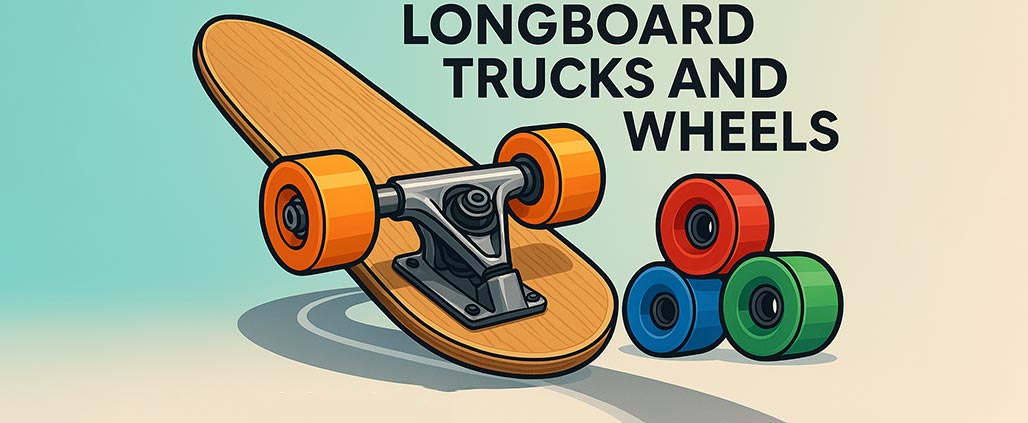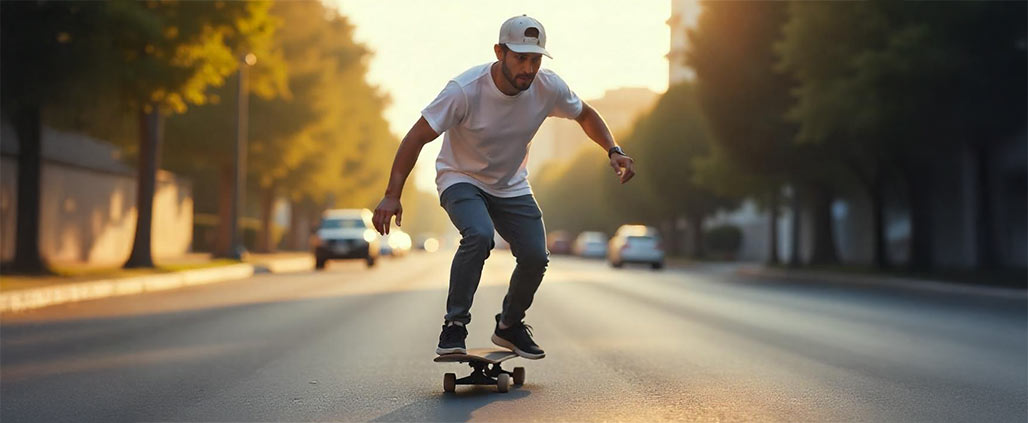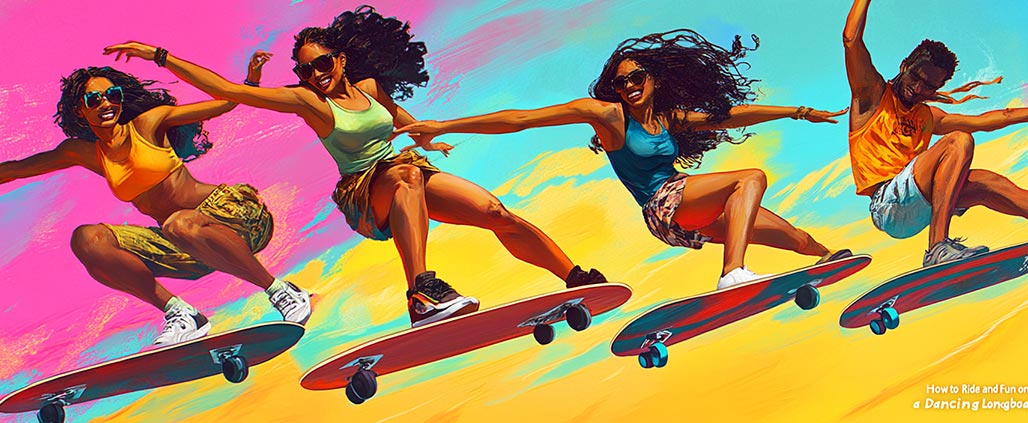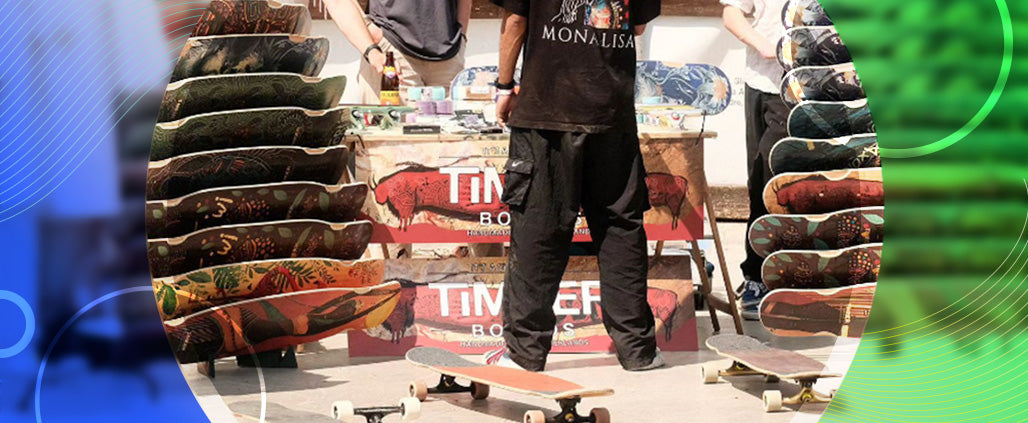
Longboard Trucks and Wheels Guide: Find Your Perfect Setup
Key Takeaways
- Truck Types: Reverse Kingpin Trucks (RKP) excel for carving and downhill, while Standard Kingpin Trucks (SKP) work better for technical riding
- Wheel Size: Larger wheels (70-75mm) provide better roll speed and smooth rides, smaller wheels (60-65mm) offer quicker acceleration
- Durometer: Softer wheels (78a-83a) grip better and absorb shock, harder wheels (85a+) slide easier and last longer
- Riding Style: Your preferred riding style should determine your component choices—not the other way around
- Compatibility: Always check that your truck's width matches your deck width to prevent wheel bite
Introduction: Why Trucks and Wheels Matter
If you've ever wondered why some longboards feel amazing while others feel like pushing a shopping cart with a wobbly wheel, the answer usually comes down to two things: trucks and wheels. These components aint just random parts—they're the foundation of how your board performs, feels, and reacts to everything you do.
Whether you're cruising the boardwalk, bombing hills, or practicing your slides, your trucks and wheels dictate stability, turning ability, grip, and overall ride quality. The wrong setup can make even the most beautiful deck feel terrible, while the right combination can transform an average board into your favorite ride.
Lemme break down everything you need to know about choosing the perfect trucks and wheels for your riding style, skill level, and preferences. By the end, you'll know exactly what to look for and how these components work together to create your ideal ride experience.
Understanding Longboard Trucks: The Foundation of Your Setup
Types of Trucks: Standard vs. Reverse Kingpin
Longboard trucks come in two main varieties, and choosing between them is your first big decision.
Standard Kingpin (SKP) trucks look similar to what you'd find on a regular skateboard. They're characterized by the kingpin (the big bolt that holds everything together) pointing inward toward the center of the board. These trucks sit lower to the ground and offer excellent stability for technical tricks.
Gullwing Shadow 8.5 Black/Black Skateboard Trucks are a solid example of quality SKP trucks that work well for smaller cruisers and technical riding.
Reverse Kingpin (RKP) trucks have the kingpin facing away from the center, which creates a completely different ride feel. RKP trucks give you more responsive turning at slower speeds while maintaining stability when going fast. This makes them the preferred choice for most longboarding styles.
I personally switched from SKP to RKP trucks when I started doing more downhill and carving, and the difference was immediately noticeable. RKP trucks give that surfy, flowy feeling that most longboarders crave, while still providing stability when you pick up speed.
Truck Width and Matching to Decks
Getting the right truck width is super important and often overlooked by beginners. Your trucks should match the width of your deck as closely as possible—ideally within 1/4 inch.
Here's why it matters:
- Too narrow: Your wheels might stick out beyond your deck, creating a twitchy, unstable ride
- Too wide: Your wheels extend too far, making turning less responsive and kicktails less effective
Things get a bit confusing because different manufacturers measure trucks differently. Some list the hanger width, while others give the axle width (from axle tip to axle tip). When in doubt, the axle width is the most reliable measurement to compare with your deck width.
Most longboard decks work well with trucks in the 150-180mm range. For example, the Caliber III 158mm/44° Raked Black Longboard Trucks are perfect for decks around 9-9.5 inches wide.
Baseplate Angles and Riding Dynamics
One of the most confusing aspects for newcomers is understanding baseplate angles. The baseplate is the part of the truck that attaches to your deck, and its angle significantly affects how your board turns and feels.
- Lower angles (40-45°): More stable at speed, less turn for the same amount of lean. Great for downhill and fast freeride.
- Higher angles (47-50°+): More responsive turning, less stable at high speeds. Better for carving, cruising, and dancing.
Many experienced riders use a "split angle" setup with a lower degree in the back (for stability) and higher in the front (for turning). For instance, pairing Paris V3 180mm/43° Polished Longboard Trucks in the back with Paris V3 180mm/50° Polished Longboard Trucks in the front.
I remember my first time trying a split setup—I was blown away by how it gave me the stability I needed for confidence while still letting me carve turns without getting speed wobbles. It's like having your cake and eating it too!
Premium Truck Brands and Options
Top Brands Worth Considering
While there are plenty of budget options out there, investing in quality trucks makes a huge difference in performance and durability. These brands have consistently proven their worth:
Paris Trucks - Known for their fluid, surfy feel and exceptional durability. Paris V3s are among the most popular trucks for a reason—they strike a perfect balance between carving performance and stability.
Caliber Trucks - These trucks offer a more direct feel and exceptional stability at speed. Their precision manufacturing makes them a favorite for downhill riders.
Bear Trucks - Grizzly Gen 6 trucks have made significant improvements in recent designs, offering great versatility across riding styles.
Gullwing Trucks - Their Charger model offers excellent carving performance at a mid-range price point.
I've personally ridden all these brands, and each has its own distinct "personality." Paris trucks feel flowy and forgiving, while Calibers feel precise and direct. The truck that's "best" really depends on your personal preference and riding style.
All About Longboard Wheels
Wheel Size and Diameter
Wheel size is measured in millimeters and typically ranges from 60-80mm for longboard wheels. This dimension has a major impact on your ride:
Smaller wheels (60-70mm):
- Accelerate faster and are more responsive
- Easier to slide and perform technical maneuvers
- Better for smaller setups, freestyle, and technical freeride
- Example: Shark Wheel 60mm Clear With Blue Hub California Roll Skateboard Wheels
Larger wheels (70-80mm):
- Roll faster once up to speed and maintain momentum better
- Handle rough surfaces more effectively
- Provide a smoother ride over cracks and pebbles
- Example:

The first time I hit a patch of rough pavement with 75mm wheels after riding 65mm for years, I was shocked at how much smoother the ride was. The bigger wheels just floated over cracks that would've sent vibrations straight up my legs with smaller wheels.
Durometer and Urethane Formulation
Durometer refers to the hardness of the wheel, measured on the "A" scale for longboard wheels. The typical range for longboarding is 75a-90a.
Softer wheels (75a-82a):
- More grip and traction
- Better shock absorption on rough surfaces
- More predictable sliding behavior
- Wear faster and roll slower
- Great for rough pavement, downhill, and comfort
Harder wheels (83a-90a):
- Slide more easily and predictably
- Last longer and maintain shape better
- Roll faster on smooth surfaces
- Less grip in corners
- Better for smooth pavement and technical sliding
Beyond just the durometer number, different urethane formulations can dramatically affect performance. Premium brands like Blood Orange develop proprietary urethane formulas that optimize specific characteristics like grip, slide consistency, and rebound.
Contact Patch and Wheel Shape
The contact patch is the part of the wheel that actually touches the ground. It's width affects your grip and slide characteristics:
- Wider contact patches provide more grip and stability but make slides more abrupt
- Narrower contact patches break into slides more easily but offer less grip in corners
The shape of the wheel's edge (lip) also matters tremendously:
- Square lips grip more and are harder to slide, making them ideal for downhill and grip-intensive riding
- Round lips initiate slides more easily and slide more predictably, perfect for freeride and technical sliding
Powell Peralta Snakes have become legendary among freeriders because their rounded lip profile and unique urethane formula make sliding incredibly smooth and controllable.
Core Placement and Performance Effects
The position of the core (where the bearings sit) within the wheel affects performance more than most riders realize:
- Center-set cores place the bearings in the middle of the wheel width, allowing you to flip wheels to promote even wear
- Offset cores position the bearings slightly away from the center, providing more controlled slides
- Sideset cores place the bearings very close to the inside edge, making slide initiation easier but preventing flipping
I rode center-set wheels for years before trying offset cores, and the difference in slide characteristics was immediately noticeable. The offset wheels broke into slides more predictably and had a more controlled feel throughout the slide.
Matching Components to Riding Styles
Downhill and Speed Setups
If you're looking to bomb hills and go fast, your component choices should prioritize stability and control:
Trucks:
- Lower degree baseplates (40-44°)
- Wider hangers (180mm) for stability
- Quality precision or cast trucks like Paris Savants
- Split-angle setups are common (lower degree in back, higher in front)
Wheels:
- Larger diameter (70-80mm) for roll speed and momentum
- Medium-soft durometer (78-83a) for grip with controlled slides
- Wider contact patches with square lips for maximum grip
- Example: Venom SideShow 70mm/80A in White Longboard Wheels
The combination of these components creates a setup that remains stable at speed while still providing the control needed for taking corners at high velocity. My first proper downhill setup completely changed my confidence level—the stability made 35mph feel comfortable instead of terrifying.
Freeride and Sliding Configurations
Freeride is all about technical sliding and creative line choices, requiring equipment that facilitates controlled slides:
Trucks:
- Mid-range baseplate angles (45-47°)
- A width that matches or slightly exceeds the deck width
- Trucks with open bushing seats for fluid turning
Wheels:
- Medium diameter (65-70mm)
- Medium-hard durometer (80-86a)
- Round lips for smooth slide initiation
- Center-set or offset cores for controlled slides
- Example:

I remember the frustration of trying to learn slides with the wrong wheels—it was like hitting a brick wall every time I tried to break traction. Switching to proper freeride wheels with rounded lips made learning so much easier; slides became smooth and predictable instead of jerky and intimidating.
Cruising and Carving Considerations
For casual riding, commuting, and carving, your setup should prioritize comfort and responsive turning:
Trucks:
- Higher degree baseplates (50°+)
- RKP trucks for fluid carving sensation
- Quality bushings matched to your weight
Wheels:
- Medium to large diameter (70-75mm) for roll speed and comfort
- Softer durometer (78-80a) for shock absorption and grip
- Moderate contact patch for balance between grip and efficient pushing
- Example:

My daily commuter board uses 50° Paris V3s with 70mm 78a wheels, and it's the perfect combination for navigating urban terrain. The responsive trucks make weaving through obstacles easy, while the softer wheels soak up vibrations from rough sidewalks.
Building Your Setup: Compatibility Considerations
Avoiding Wheel Bite
Wheel bite occurs when your wheels contact your deck during turns, causing an abrupt stop that often results in falling. To prevent this:
- Ensure proper truck width relative to deck width
- Use appropriate risers if needed (1/8" to 1/4" for most setups)
- Select wheel diameter appropriate for your deck design
- Consider cutouts or wheel wells in your deck design
Truck and Wheel Width Relationship
The width of your trucks affects the leverage you have over your wheels:
- Wider trucks with wider wheels = more stability, less agility
- Narrower trucks with narrower wheels = more agility, less stability
For most all-around longboarding, a balanced approach works best. Trucks around 180mm wide with wheels around 70mm in diameter provide a versatile foundation that works for most riding styles.
Maintenance Tips for Longevity
Truck Maintenance
- Regularly check and tighten all bolts and kingpins (but not too tight!)
- Clean and regrease pivot cups when they start squeaking
- Replace bushings when they show significant wear or lose their rebound
- Straighten bent hangers immediately (or replace if severely bent)
Wheel Maintenance
- Rotate wheels regularly to promote even wear (if using center-set cores)
- Clean bearings every 1-2 months, depending on riding conditions
- Replace wheels when they develop flat spots or cone severely
I learned the importance of maintenance the hard way when my neglected bearings seized up mid-ride. Now I keep a skate tool with me during sessions so I can make quick adjustments as needed.
Conclusion: Finding Your Perfect Setup
There's no single "best" truck and wheel combination—it all depends on your riding style, preferences, and the terrain you typically ride. Start with understanding the basics we've covered, then consider what aspects of performance matter most to you.
For beginners, I generally recommend:
- Paris V3 180mm 50° trucks
- 70mm wheels with 78-80a durometer
- 1/8" risers to prevent wheel bite
This setup provides a versatile foundation that works well for learning various riding styles before specializing further.
Remember that experimentation is part of the fun! Try different setups, borrow friends' boards, and pay attention to how small changes affect your ride. Over time, you'll develop preferences that help you find your perfect setup.
FAQ: Common Questions About Trucks and Wheels
What's the difference between TKP and RKP trucks?
TKP (Traditional Kingpin) is another name for Standard Kingpin trucks, while RKP refers to Reverse Kingpin. The main differences are the kingpin orientation, ride height, and turning characteristics. RKP trucks generally offer more turn and lean, making them preferred for most longboarding styles.
How do I know what size trucks I need?
Measure your deck width and try to match your truck axle width as closely as possible. For most longboards between 9-10" wide, trucks in the 150-180mm range work well. When in doubt, slightly wider is usually better than too narrow.
Can I use skateboard wheels on a longboard?
Yes, but with limitations. Traditional skateboard wheels (52-56mm) will work physically, but they'll provide a rougher ride and less rolling speed compared to longboard wheels. For most longboarding, wheels 65 mm+ are recommended for a better experience.
What are the best wheels for rough roads?
For rough roads, look for larger (70-75mm), softer (75a-78a) wheels with a wider contact patch. Wheels like Orangatang Kegels or Sector 9 Race Formula excel at absorbing vibrations and rolling over obstacles.
How tight should my trucks be?
This is largely personal preference. Tighter trucks (firmer bushings or tighter kingpin) provide more stability but less turning, while looser trucks turn more easily but can feel unstable at speed. Start moderately tight where the bushings just begin to compress, then adjust based on feel.
Are expensive trucks worth it?
For beginners, mid-range cast trucks ($40-70) offer excellent performance. As you advance, higher-end trucks ($100+) provide noticeable benefits in precision, reduced slop, and specialized performance characteristics. Most riders find the sweet spot with quality cast trucks like Paris V3s or Caliber IIIs rather than full precision trucks.
How often should I replace my wheels?
Wheels should be replaced when they show significant uneven wear (coning), develop flat spots that affect ride quality, or wear down to 85% or less of their original diameter. With proper rotation and care, quality wheels can last 6-12 months of regular riding.








